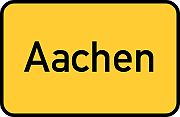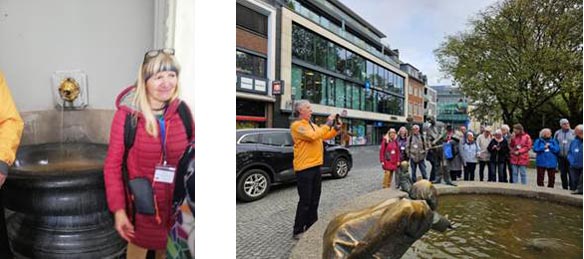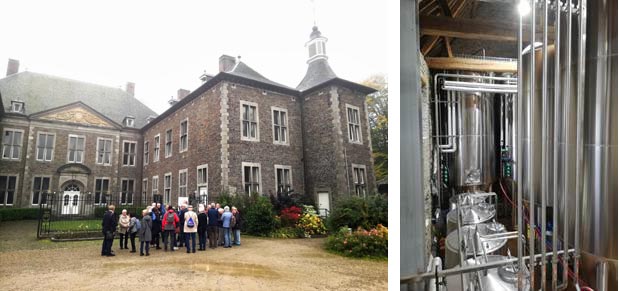Multi-Sectional Meeting in Aachen
14 to 20 October 2024 This meeting was organised by the Bonn Section and took place in the border triangle of Aachen. In addition to the partner sections, the invitation was open to all members of Eurojumelages. 82 participants were registered, but the number varied as some people joined the event only on a daily basis. The Section of Darmstadt was represented by Karola and myself. On the day of arrival we walked to the Aachener Brauhaus, where we ate dinner.
This meeting was organised by the Bonn Section and took place in the border triangle of Aachen. In addition to the partner sections, the invitation was open to all members of Eurojumelages. 82 participants were registered, but the number varied as some people joined the event only on a daily basis. The Section of Darmstadt was represented by Karola and myself. On the day of arrival we walked to the Aachener Brauhaus, where we ate dinner.
The programme for Tuesday consisted of guided visits of the historic centre of Aachen and the cathedral. At the location of the current old town, in ancient times there was already in existence a Roman settlement. Remains thereof are visible in numerous so called “Archaeological windows”. In 1165 Emperor Frederik Barbarossa raised the settlement around the royal palace to a free imperial city. In the fourteenth century a new town hall was built on the ruins of the King’s hall of the old palace, and a gothic chancel was attached to the octagon of the palatine chapel. The medieval town consisting mainly of wooden and half-timbered houses was extensively destroyed by fire in 1656. The reconstruction took place initially in Renaissance style, and later superseded by baroque. During the Second World War substantial parts of the old town were once again destroyed. The rebuilding was undertaken with careful preservation of the medieval street courses and most of the large buildings indicative of the cityscape.

The „Elisenbrunnen“ fountain was completed in 1827 and is one of the landmarks of the health and spa resort that is Aachen. Karola supplied herself with the sulfurous water during the whole stay. A character on the fountain „Merry-go round of Money” (Kreislauf des Geldes-Brunnen) held the flag of Eurojumelage for the photo.

The „Puppenbrunnen“ fountain shows figures and masks relevant to Aachen from the characteristic or historical point of view. Parts thereof are movable and can be reshaped. „Postwagen“ is the present name of two historic buildings attached to the eastside of the townhall of Aachen. Between 1860 and 1910 the building on the right was known as house „Zum Eulenspiegel“.
The cathedral with its numerous transformations and extensions is over 1200 years old and is influenced by various style epochs. It was the coronation church of 30 German kings and is also the burial place of Charlemagne. The octagon is the most significant architectural example of Carolingian Renaissance. Towards the end of the eight century Charlemagne commissioned the construction of the central and the west part which formed the core of his Carolingian palace. From the townhall one can look over the square „Katschhof” onto the north facade of the cathedral. The Carolingian throne in the upper floor is a simple marble chair.
 After lunch in the restaurant „Luna“, we had free time in the afternoon. I used it to visit three music stores. In one of them I was able to try out two left-hand western guitars. For dinner we met again in the „Aachener Brauhaus“.
After lunch in the restaurant „Luna“, we had free time in the afternoon. I used it to visit three music stores. In one of them I was able to try out two left-hand western guitars. For dinner we met again in the „Aachener Brauhaus“.
On Wednesday we took a day trip to Maastricht with two buses. Maastricht is located in the extreme southeast of the Netherlands between Belgium and Germany. Tourism is an important economic sector of the oldest city of the Netherlands where one can find many sights, shopping facilities, restaurants and pubs. Furthermore lots of conferences, meetings and events take place here. Worth mentioning is the Maastricht Treaty signed here in 1992, paving the way for the EU towards an economic and monetary union, common foreign and security policy as well as cooperation in justice and home affairs. A guided tour through the old town and a short cruise on the river Meuse were planned, but the latter was cancelled due to a blocked sluice. Instead of the short ship cruise we made a round trip with the solar-powered „Sonnenzug“.
 The “Vrijthof” is the main square of Maastricht with the Protestant Saint John's church and its striking red tower together with the Catholic Saint Servatius Basilica. Since 2005 André Rieu organises here annually in summer several open air concerts to an audience of about 12000 persons each evening. Dutch and English books are offered in the bookshop „Dominicanen“ under the stone vault of a medieval church. “Sint Servaasbrug” is an arched stone bridge across the river Meuse near the position of the original Roman bridge. It is named after Saint Servatius, the first bishop of Maastricht, and this is considered to be the oldest bridge in the Netherlands. It was frequently modified, renovated, bombed, blown up and built anew.
The “Vrijthof” is the main square of Maastricht with the Protestant Saint John's church and its striking red tower together with the Catholic Saint Servatius Basilica. Since 2005 André Rieu organises here annually in summer several open air concerts to an audience of about 12000 persons each evening. Dutch and English books are offered in the bookshop „Dominicanen“ under the stone vault of a medieval church. “Sint Servaasbrug” is an arched stone bridge across the river Meuse near the position of the original Roman bridge. It is named after Saint Servatius, the first bishop of Maastricht, and this is considered to be the oldest bridge in the Netherlands. It was frequently modified, renovated, bombed, blown up and built anew.

Lunch buffet was served on board of the moored ship. In the afternoon we visited the fortress St. Pieter built around 1700 and successfully defended against all attacks. The fort houses a maze of underground passages and tunnels and was also used to hide people and art treasures from German occupying forces during World War II. We were guided with lamps through a part of the 14 km long mine and brick tunnels. After our excursion, dinner for all was held in the restaurant „Zum wehrhaften Schmied“ in Aachen.
On Thursday we went to the Eifel where we had multiple stops. First we visited the Roman glassworks on the outskirts of Monschau. The glass smelting furnace has an operating temperature of about 1280 degrees Celsius, the cooling chambers of 480 degrees. Here we were shown how to manufacture vessels and figurines out of a glowing mass using traditional tools. Among other things, the two glassblowers produced also a glass owl. Afterwards we had lunch in the restaurant of the hotel “Horchem”, followed by a guided city tour.

The old town of Monschau is located in the Rur valley and full of historical buildings and half-timbered houses. The ruin of the fortification “Haller” enthrone on a ridge beside the river Rur. The production of textiles in Monschau started end of the sixteenth century, with the climax of textile industry being reached in the eighteenth century. A still visible symbol of the heyday of this industry is the magnificent “Red House” constructed around 1760 by the manufacturing family Scheibler. The fountain „Tuchmacherbrunnen” on the marketplace features the three most important professions in the textile manufacture: weaver, dyer and shearer. Since the early 1970s the old town of Monschau also served as the backdrop scenery for a series of films.

Later on we drove on to Rurberg. There we had the opportunity to visit the exhibition „Life lines of nature“ in the National Park Gate. Afterwards we took a boat to the village Schwammenauel at the other end of the lake Rur where the buses were waiting for us. After our return to Aachen dinner was served for everybody in the restaurant „Elisenbrunnen“.
An excursion to Liège was planned for Friday. On the way to Liège we stopped in Val-Dieu at the Cistercian abbey which also has its own brewery. The abbey Val-Dieu was founded by Cistercian monks in 1216. It consists of the remains from the thirteenth century as well as buildings from the seventeenth, eighteenth and nineteenth century. Since the departure of the monks in 2001, the Christian community of volunteers has continued to care for the preservation of the abbey. After a beer tasting we had the opportunity to also see the modern brewery.

After lunch in the mill restaurant we drove on to Liège. First we had a guided city tour which was unfortunately a bit short due to our delayed arrival. Afterwards we visited the Palace of the Bishop Princes. After Charleroi, Liège is the second largest city in Wallonia, capital of the province of the same name and domicile of the bishopric. It is also the cultural centre of the Walloon region in Belgium. Liège was once the centre of heavy industry had the nickname of “the glowing city” due to its numerous blast furnaces. Since the 1970s the heavy industry largely disappeared leading to permanent high unemployment in the region. A new tram network that has been planned for a long time will become operational in 2025.

At the market place there are many listed buildings, including the “Perron” and the town hall which are landmarks of the city. The „Montagne de Bueren“ is the second largest stairway in Belgium with a total of 374 steps.

The Palace of the Bishop Princes is a large architectural building complex. It was constructed at the place where the St. Lambert cathedral stood earlier. Presently it is the seat of the court house and the provincial government. The large courtyard is surrounded by arcade galleries and pillars with a design inspired by Lombard art. Back in Aachen we were served dinner in the restaurant “Novotel Aachen City”.
On Saturday morning we visited the neo-Gothic town hall of Aachen. During the welcome by the deputy mayoress of central Aachen we learned also details on current policy issues. The town hall was built on the ruins of the palace of Charlemagne at the beginning of the fourteenth century. The fountain “Karlsbrunnen” stands in front of the town hall on the market square. The spacious coronation hall in which faithful reproductions of the imperial regalia are exhibited – among them the crown, the sword and the Gospel Book – are reminiscent of the period between 936 and 1531 when the feasts of the royal coronations took place here.
 After lunch again in the restaurant „Luna“, we had free time in the afternoon. For the final dinner we met in the restaurant “Ratskeller”. The delicious three-course menu was followed by acknowledgements from the partner sections of Bonn which were also translated. Willi Elz played very engaged music, first for singing along and then for dancing.
After lunch again in the restaurant „Luna“, we had free time in the afternoon. For the final dinner we met in the restaurant “Ratskeller”. The delicious three-course menu was followed by acknowledgements from the partner sections of Bonn which were also translated. Willi Elz played very engaged music, first for singing along and then for dancing.
 This meeting will surely remain in special memory for all participants. Besides the extensive cultural program there were many opportunities to exchange views and make new friendships. Appreciation and great praise are due to the members of the section Bonn for planning and undertaking this unique event.
This meeting will surely remain in special memory for all participants. Besides the extensive cultural program there were many opportunities to exchange views and make new friendships. Appreciation and great praise are due to the members of the section Bonn for planning and undertaking this unique event.
Thomas Rosowski
Association of Darmstadt
Germany



